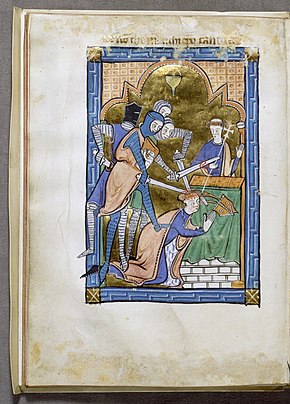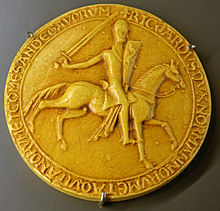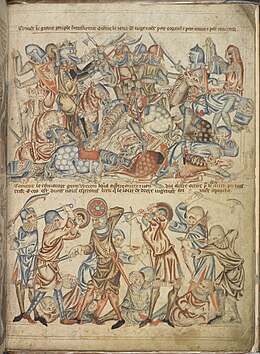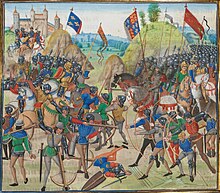House of Plantagenet
The king was no longer just the most powerful man in the nation, holding the prerogative of judgement, feudal tribute and warfare, but had defined duties to the realm, underpinned by a sophisticated justice system.It culminated in the Battle of Bosworth Field in 1485, when the reign of the Plantagenets and the English Middle Ages both met their end with the death of King Richard III.Henry VII, a Lancastrian, became king of England; five months later he married Elizabeth of York, thus ending the Wars of the Roses and giving rise to the Tudor dynasty.One of many popular theories suggests the blossom of the common broom, a bright yellow ("gold") flowering plant, called genista in medieval Latin, as the source of the nickname.The retrospective usage of the name for all of Geoffrey's male-line descendants was popular during the subsequent Tudor dynasty, perhaps encouraged by the further legitimacy it gave to Richard's great-grandson, Henry VIII.In the early 12th century, Geoffrey of Anjou married Empress Matilda, King Henry I's only surviving legitimate child and heir to the English throne from the House of Normandy.[28] Henry reacted by getting Becket and other English bishops to recognise sixteen ancient customs in writing for the first time in the Constitutions of Clarendon, governing relations between the king, his courts and the church.When he received this news, Henry said: "What miserable drones and traitors have I nurtured and promoted in my household who let their lord be treated with such shameful contempt by a low-born clerk."[39] Once again Philip II of France attempted to disturb the Plantagenet territories on the European mainland by supporting his vassal Arthur's claim to the English crown.John won a significant victory while preventing Arthur's forces from capturing his mother, seizing the entire rebel leadership at the Battle of Mirebeau and his sister Eleanor, Fair Maid of Brittany.[44] The plan was that John would draw the French from Paris, while another army, under his nephew Otto IV, the Holy Roman Emperor, and his half-brother William attacked from the north.The barons led by Henry's brother-in-law Simon de Montfort forced him to agree to the Provisions of Oxford, under which his debts were paid in exchange for substantial reforms.Llywelyn ap Gruffudd claimed to rule North Wales "entirely separate from" England but Edward viewed him to be "a rebel and disturber of the peace".The invasion was executed by one of the largest armies ever assembled by an English king, comprising Anglo-Norman cavalry and Welsh archers and laying the foundation for future victories in France.His army was caught by a much larger French force at Poitiers, but the ensuing battle was a decisive English victory, resulting in the capture of John II of France.[72] The Plantagenets continued to interfere, and John of Gaunt, 1st Duke of Lancaster, the Black Prince's brother, married Peter's daughter Constance, claiming the Crown of Castile in her name.[71] The Black Prince's ten-year-old son succeeded as Richard II of England on the death of his grandfather, nominally exercising all the powers of kingship, supported by various councils.His government levied poll taxes to finance military campaigns which, combined with the poor state of the economy, resulted in the Peasants' Revolt in 1381, followed by brutal reprisals against the rebels.Initially, they were successful in establishing a commission to govern England for one year, but they were forced to rebel against Richard, defeating an army under Robert de Vere, Earl of Oxford, at the skirmish of Radcot Bridge.Many Lancastrians asserted that his mother had had legitimate rights through her descent from Edmund Crouchback, who it was claimed was the elder son of Henry III of England, set aside due to deformity.During the minority of Henry VI the war caused political division among his Plantagenet uncles, Bedford, Humphrey of Lancaster, 1st Duke of Gloucester, and Cardinal Beaufort.[84] Depopulation stemming from the Black Death led to increased wages, static food costs and a resulting improvement in the standard of living for the peasantry.[92] When Henry's sanity returned, the court party reasserted its authority, but Richard of York and the Nevilles defeated them at a skirmish called the First Battle of St Albans.Edward and Richard, Duke of Gloucester, fled, but on their return, Clarence switched sides at the Battle of Barnet, leading to the death of the Neville brothers.[104] When Henry VII, of England seized the throne there were eighteen Plantagenet descendants who might today be thought to have a stronger hereditary claim, and by 1510 this number had been increased further by the birth of sixteen Yorkist children.John de la Pole, 1st Earl of Lincoln, joined the revolt, probably anticipating that it would further his own ambitions to the throne, but he was killed in the suppression of the uprising at the Battle of Stoke Field in 1487.[110] John de la Pole's attainder meant that his brother Edmund inherited their father's titles, but much of the wealth of the duchy of Suffolk was forfeit.In 1513, he was executed after Richard de la Pole, whom Louis XII of France had recognised as king of England the previous year, claimed the kingship in his own right.According to the Calendar of State Papers, her execution was botched at the hands of "a wretched and blundering youth ... who literally hacked her head and shoulders to pieces in the most pitiful manner".[115] As late as 1600, with the Tudor succession in doubt, older Plantagenet lines remained as possible claimants to a disputed throne, and religious and dynastic factors gave rise to complications.








Gwynedd
, Llywelyn ap Gruffudd's principality
Territories conquered by
Llywelyn ap Gruffudd
Territories of Llywelyn's vassals
Lordships of the
Marcher barons
Lordships of the King of England
Kingdom of England









Plantagenet (disambiguation)Armorial of PlantagenetHouse of IngelgerKingdom of EnglandKingdom of FranceLordship of IrelandPrincipality of WalesHoly Roman EmpireGeoffrey V of AnjouHenry Somerset, 12th Duke of BeaufortRichard III of EnglandKing of EnglandKing of FranceKing of the RomansKing of SicilyLord of IrelandLord of CyprusPrince of WalesDuke of AquitaineDuke of NormandyDuke of BrittanyDuke of GasconyDuke of CornwallDuke of GloucesterDuke of ClarenceDuke of AumaleCount of AnjouCount of MaineCount of MortainCount of NantesCount of PoitouEarl of BuckinghamEarl of CornwallEarl of ChesterEarl of EssexEarl of UlsterEarl of NorfolkEarl of KentEarl of LancasterEarl of LeicesterEarl of SalisburyEarl of RichmondHouse of LancasterHouse of YorkHouse of BeaufortPeriodsEnglish historyPrehistoric BritainRoman BritainSub-Roman BritainAnglo-SaxonNorman/AngevinPlantagenetElizabethanStuartJacobeanCarolineInterregnumRestorationGeorgian eraRegency eraVictorian eraEdwardian eraFirst World WarInterwar BritainSecond World WarPost-war Britain (political)Post-war Britain (social)Political history (1979–present)Social history (1979–present)Timelineroyal houseFrenchcounty of AnjouAngevinsLancastercadet branchesEnglish throneHenry IIRichard IIIMagna CartaMiddle EnglishHundred Years' WarHenry VIWars of the RosesBattle of Bosworth FieldEnglish Middle AgesHenry VIIElizabeth of YorkTudor dynastyEnglish Renaissanceearly modern BritainUnited KingdomRichard of York, 3rd Duke of YorkGeoffreycommon broomgenistamedieval LatinHenry VIIIAngevin kings of EnglandAngevin EmpireRichard IHouse of NormandyHouse of Wessexcounts and dukes of AnjouCapetian House of AnjouValois House of AnjouHenry IIIKate NorgateWilliamRichardMatildaEleanorcounts of AnjouGeoffrey II, Count of GâtinaisErmengarde of Anjoucognatic kinshipan Angevin familyIngelgerNormandyBrittanyPoitouEmpress MatildaKing Henry IFulk V, Count of AnjouWilliam Adelin
